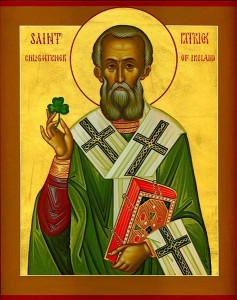 A favorite hymn, which we sing every year on the Feast of the Most Holy Trinity, is “I bind unto myself today the strong Name of the Trinity,” attributed to St. Patrick. Although the oldest manuscripts containing this poem date from the eleventh century, there are many older allusions to it and the legend of its origin (told by the Irish monk Muirchu in the 7th century) is a wonderful testament to the courage of Christian missionaries and to their use of elements of the local culture to bring converts to the Christian faith.
A favorite hymn, which we sing every year on the Feast of the Most Holy Trinity, is “I bind unto myself today the strong Name of the Trinity,” attributed to St. Patrick. Although the oldest manuscripts containing this poem date from the eleventh century, there are many older allusions to it and the legend of its origin (told by the Irish monk Muirchu in the 7th century) is a wonderful testament to the courage of Christian missionaries and to their use of elements of the local culture to bring converts to the Christian faith.
As the story goes, Patrick (a Roman Briton who had been held captive as a slave in Ireland in his youth) was consecrated as a bishop to return to the land of his servitude to bring the light of Christianity to the Irish people. The dramatic lighting of the Paschal fire against the explicit rule of King Loegaire on the night when a Druid celebration with fire was to take place at Tara was the beginning of the battle for the souls of the Irish people. The King feigned acceptance of Patrick’s presence to lure him to Tara to have him killed.
As Patrick and the monks who accompanied him made their way toward Tara, with the King’s soldiers lying in ambush waiting to attack, a dark mist surrounded them and they were perceived by the soldiers as deer. Going through this “valley of the shadow of death,” Patrick sang this song to bring courage to the monks and to pray for their protection against the evil which surrounded them. The song is called “The Deer’s Cry” because of the appearance of Patrick and the monks and it is also called the lorica, or breastplate, of St. Patrick as it is reminiscent of St. Paul’s admonition to put on the “breastplate of righteousness”, the “shield of faith”, the “helmet of salvation”, and the “sword of the spirit.” [Ephesians 6]
The Druids’ incantations were similar in style – words which were thought to protect against enemies – but in St. Patrick’s song, the Name of the Holy Trinity is called upon for protection against the murderous methods of those very Druids: the “wizard’s evil craft, the death-wound and the burning, the choking wave, the poisoned shaft.”
St. Patrick’s “lorica” was preserved and much loved by the Irish, as they gradually became a Christian nation. It is thought that some written versions had the words so arranged that they visually formed a circular shield or breastplate themselves. It is not known what music these words were sung to in earlier times, but in the late 19th century, a Protestant pastor’s wife, Cecil Frances Alexander, made a metrical paraphrase which has been set to two old Irish melodies. This is the version which appears in The St. Ambrose Hymnal.
As we sing this favorite hymn on Trinity Sunday, may we again ask for the protection of the Holy and Blessed Trinity – three Persons in one God – against all the evils of our society today. And may we give thanks for the courage and wisdom of saints such as Patrick as they helped to spread faith in the Father, the Son, and the Holy Spirit throughout the world.
Resources: Lindisfarne Letter: Celtic Christianity by Christopher Bamford; The Hymnal 1940 Companion; The Stories of Hymns by Fr. George Rutler.